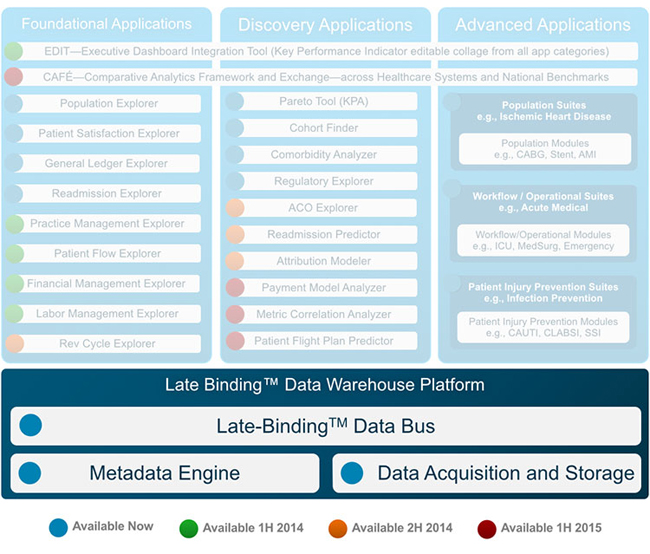Data Warehouse Platform
An enterprise data warehouse (EDW) forms the foundation for healthcare analytics. Most large healthcare organizations have hundreds of different technology solutions from various vendors. Without bringing all of this data into a single source of organizational truth, it is impossible to provide reliable and repeatable reporting and analysis. From the foundation of the EDW, organizations can progress to registries and reporting, population health, and clinical and financial risk modeling.
Health Catalyst’s Late-Binding™ Data Warehouse is our architectural model for analytics in healthcare. The Late-Binding™ architecture avoids the pitfalls of early binding architectures espoused by Inmon, Kimball, and others.
Here is a diagram representing the Health Catalyst 2.0 Platform and Application stack. Below is a description of the key components of the Late-Binding ™ Data Warehouse platform

Many data warehouse architectures that have worked in industries such as retail or manufacturing force early data bindings to proprietary enterprise data models. Unfortunately in healthcare, these have proven to be inflexible, one-size-fits-all architectures that force data from different systems into models enforcing a compromised, least common denominator warehouse. The Health Catalyst Late-Binding™ Architecture avoids the inherent weaknesses of early binding models.
The enterprise data model also requires massive transformations of data whereas late-binding retains its original, undiluted value by delaying data binding until the proper time and context in which it is is needed.
The following is are the principles supporting Catalyst’s approach to analytics. These principles have enabled data warehouses in manufacturing, the military, and healthcare that have been fully functional and adapting for over 20 years with an unmatched track record for proven results.
- Minimize remodeling data in the data warehouse until the analytic use case requires it. Leverage the natural data models of the source systems by reflecting much of the same data modeling in the data warehouse.
- Delay binding to rules and vocabulary as long as possible until a clear analytic use case requires it.
- Earlier binding is appropriate for business rules or vocabularies that change infrequently or that the organization wants to lock down for consistent analytics.
- Late binding in the visualization layer is appropriate for what-if scenario analysis.
- Retain a record of the changes to vocabulary and rule bindings in the data models of the data warehouse. This will provide a self-contained configuration control history that can be invaluable for conducting retrospective analysis that feeds forecasting and predictive analytics.
Download the Data Warehouse eBook to learn more.
